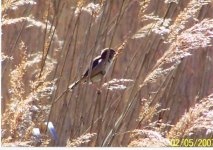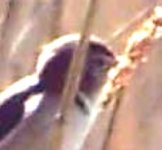-
Welcome to BirdForum, the internet's largest birding community with thousands of members from all over the world. The forums are dedicated to wild birds, birding, binoculars and equipment and all that goes with it.
Please register for an account to take part in the discussions in the forum, post your pictures in the gallery and more.
You are using an out of date browser. It may not display this or other websites correctly.
You should upgrade or use an alternative browser.
You should upgrade or use an alternative browser.
Who is hiding in the reeds? (1 Viewer)
- Thread starter Aiden
- Start date
More options
Who Replied?
Hi Aiden I see this is your first post, so may I welcome you on behalf of the Staff and Moderators at Bird Forum
I'm sorry I can't help with the identification, but I'm sure there'll be someone along soon who can.
D
I'm sorry I can't help with the identification, but I'm sure there'll be someone along soon who can.
D
MikeDB
Jack in the Green
looks like a Sedge Warbler Aiden
Yep, bigger screen and finally worked out which way the bird is facing.
Mike
JWN Andrewes
Poor Judge of Pasta.
Looks more like Reed Warbler to me, would expect to see more of the super, even in that rather awkward light, if it were Sedge.
James
James
deborah4
Well-known member
Looks more like Reed Warbler to me, would expect to see more of the super, even in that rather awkward light, if it were Sedge.
James
Dark lores, James, super extends behind eye and well above it, pale cheeks, dark brow compared with rest of head, and dark shoulder 'patch' - admittedly difficult and overexposed/burnt out pic (no offense to photographer!) so perhaps not straight forward.
have lightened/upped contrast a bit:
Attachments
Last edited:
Ian Hamiltan
Well-known member
do i notice a ring on it left leg..
deborah4
Well-known member
I'd favor Reed W too...
you could be right, 'normally' the super would be more visible. Unfortunately, the whole of the face is not only in shadow but there's significant bleeding when pics upped to 500+ - the mantle tones colour on enlarged pic seems to show varigated darkness with warmer tones suggesting presence of streaking, the head tones are greyish on the top of the crown contrasting with nape, there appears to be a continuous 'line' of some sort from front to back above super/extending at the most exposed/sun side of the head. The contrast between the brow/to back of head that's still in shadow, is actually quite dark compared to super. The back of the super unfortunately is either obscured by reed or 'burnt' out. IMV, don't think it's straightforward but not willing to get involved in another long and protracted SW/? debate
Last edited:
hannu
Well-known member
This bird is not worthy of the debate.
The big contrast of the bird is attributable to the strong back ligth.
So we can not appreciate just at all to the colour of the bird.
In my experience and mind,
the general jizz differs somewhat between these species.
E.g.
the superc is clearly too narrow for Sedge,
also Sedge has more often 'the beer belly' whereas Reed has more slim body,
possibly the length of tail looks mostly shorter in Sedge than in Reed,
and possibly typical posture is mostly more vertical in Sedge than in Reed.
Of course, these are mainly relative features...;-)
See the follow link (Sedge):
http://www.tarsiger.com/images/digimies/20040708_CRW_7297.JPG
The big contrast of the bird is attributable to the strong back ligth.
So we can not appreciate just at all to the colour of the bird.
In my experience and mind,
the general jizz differs somewhat between these species.
E.g.
the superc is clearly too narrow for Sedge,
also Sedge has more often 'the beer belly' whereas Reed has more slim body,
possibly the length of tail looks mostly shorter in Sedge than in Reed,
and possibly typical posture is mostly more vertical in Sedge than in Reed.
Of course, these are mainly relative features...;-)
See the follow link (Sedge):
http://www.tarsiger.com/images/digimies/20040708_CRW_7297.JPG
Last edited:
bitterntwisted
Graham Howard Shortt
First impression this AM was Reed Warbler. Read all posts today and still think Reed Warbler. I guess this is the maligned zen approach to ID but no amount of detailed analysis can for me overcome this being a slim, plain bird without an obvious super rather than a streaky, bouncy bird with a patterned face.
Graham
Graham
hannu
Well-known member
Pointedly just superc makes it Reed Warbler,
[a) the border between the supercilium and the forehead is mostly rather distinct in this bird (some diffuse due to shadow; sedge's sc has usually very distinct and sharp),
b) the supercilium continues mostly rather distinctly to above eye in this bird (sedge's sc has distinct, sharp and wide),
c) but not continue beyond clearly (sedge's most strongest part of the superc often starts from above the eye continuing beyond the eye, but it varies individually and depending on the angle).
[a) the border between the supercilium and the forehead is mostly rather distinct in this bird (some diffuse due to shadow; sedge's sc has usually very distinct and sharp),
b) the supercilium continues mostly rather distinctly to above eye in this bird (sedge's sc has distinct, sharp and wide),
c) but not continue beyond clearly (sedge's most strongest part of the superc often starts from above the eye continuing beyond the eye, but it varies individually and depending on the angle).
Stephen Menzie
Being English isn't about hate. It's about disgust
It's a warbler. It's in reeds. 'Nuff said.
jeff
Well-known member
Hi, can anyone identify the bird hiding in the reeds?
Thanks, Aiden
Aiden,
Glad you found the place, i'm still sticking to my Reed Warbler guess, at least i'm not on my own

Another vote for Reed Warbler
Users who are viewing this thread
Total: 2 (members: 0, guests: 2)





